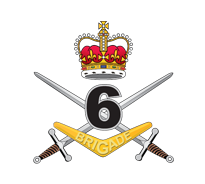6th Brigade (Australia)
| 6th Brigade | |
|---|---|
 |
|
| Active | 1915–96 2010–current |
| Country |
|
| Allegiance |
|
| Branch |
|
| Type |
Infantry (1915–96) Command support and intelligence, surveillance, target acquisition and reconnaissance (2010–current) |
| Size | 3,500 (Active) |
| Part of |
2nd Division (1915–20 & 1991–96) 4th Division (1920–44) 5th Division (1944–45) 3rd Division (1948–91) Forces Command (2010–current) |
| Engagements |
First World War Second World War |
| Insignia | |
| Unit Colour Patch |  |
First World War
Second World War
The 6th Brigade is an Australian Army brigade. First formed during the First World War as an infantry unit of the Australian Imperial Force, the brigade served at Gallipoli and in France and Belgium on the Western Front. In the 1920s, as part of a reorganisation of the Australian Army, it became part of the 3rd Military District of the Citizens Military Force, encompassing units from Victoria and South Australia. In 1991, it became part of the Ready Reserve Scheme, based at Enoggera Barracks, in Brisbane, Queensland, before being disbanded in 1996 when the scheme was discontinued. The brigade was re-raised on 1 March 2010 to oversee the Army's command support and intelligence, surveillance, target acquisition and reconnaissance (CS & ISTAR) units.
Originally formed in early 1915, the brigade consisted of four infantry battalions—the 21st, 22nd, 23rd and 24th Battalion—all of which were raised in Victoria. After being sent to Egypt in June 1915 with the 2nd Division as part of an expansion of the Australian Imperial Force, the brigade was sent to Gallipoli in September, however, as the last Allied offensive had come to an end the previous month, from then up until December 1915 when the Anzacs were evacuated from the peninsula, the brigade was not involved in any significant engagements. Later, in 1916, they were transferred to the Western Front, where they took part in the fighting in the trenches until the end of the war.
...
Wikipedia
